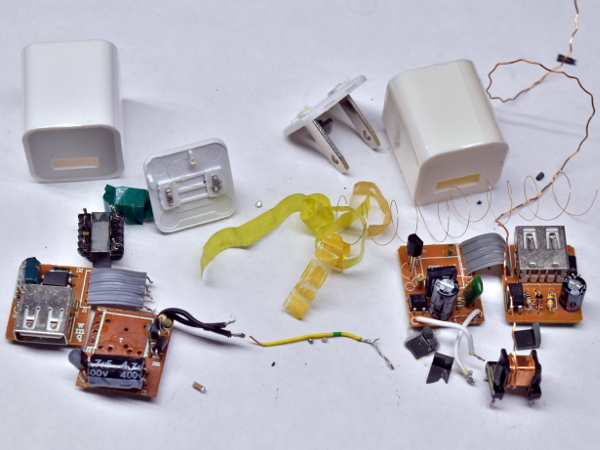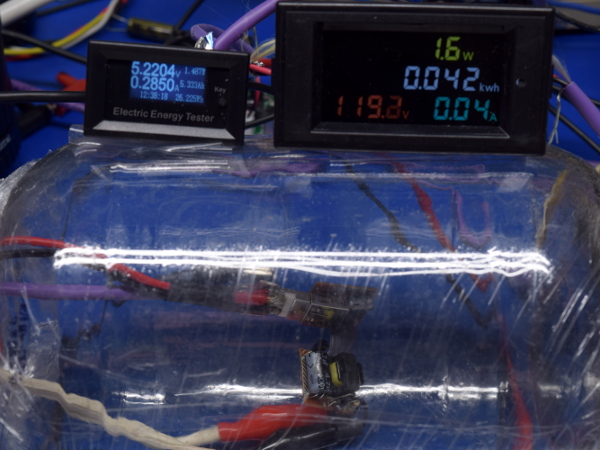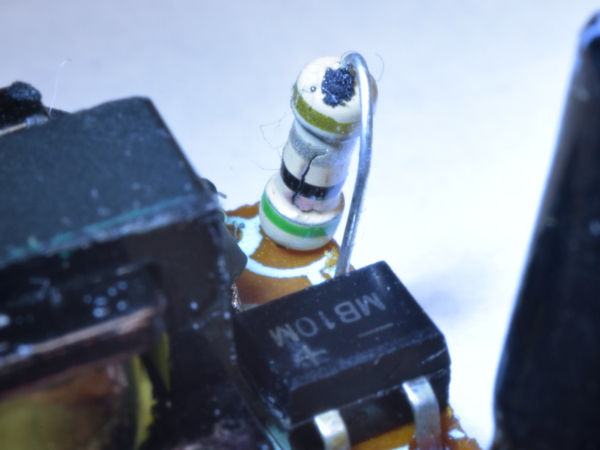Tom's Teardown: Two More Apple A1265 iPhone Charger Lookalikes
Output Voltage Regulation
Since both adapters use the zener and optoisolator setup, they both hover around the same 5.2V due to a combination of the 3.9V zener voltage, 1.2V isolator LED forward voltage, and voltage drop across the LED’s current-limiting resistor.
Neither adapter does a particularly good job of maintaining a steady output voltage due to how every component value in a flyback oscillator affects most of its properties, such as sensitivity to photo-transistor feedback. At higher oscillator current, it takes more feedback current to rein the oscillator back. Looking at the BDL1000’s steeper upward trend past 500mA on 230V, perhaps this played a part in its failure too.
MORE: Apple 5W Adapter Knock-offs: The Colorful A1265 Teardown
MORE: 10 Inexpensive Automotive USB Adapters, Tested
Peak-to-Peak Output Noise
When it comes to peak-to-peak noise, the BDL1000 is semi-horrible. Meanwhile, the A1265 could be considered ok-ish if it didn’t cut off at a mere 440mA on 115V. That's the reason for its particularly bad performance there, courtesy of its half-wave rectifier input.
MORE: Apple 5W Adapter Knock-offs: The Colorful A1265 Teardown
MORE: 10 Inexpensive Automotive USB Adapters, Tested
Get Tom's Hardware's best news and in-depth reviews, straight to your inbox.
RMS Output Noise
Things look more tame in terms of result uniformity on the RMS side. The BDL1000 is still uniformly bad, and the A1265 pretender is still passable at best (and nowhere near the 10-20mVRMS seen on Aukey’s PA-U32).
MORE: Apple 5W Adapter Knock-offs: The Colorful A1265 Teardown
MORE: 10 Inexpensive Automotive USB Adapters, Tested
Two More Down
Safety-wise, the BDL1000 (right) turned out every bit as horrible as the Colorful A1265, with even worse efficiency and possibly a penchant for self-destruction. The fake white A1265 fares a little better in the EMI capacitor failure department. Its capacitor withstands 600V after failure instead of only 300V. And I was quite surprised that its circuit board withstood in excess of 2kV before arcing over, while its transformer almost scored a pass. Although its output was considerably cleaner than the BDL1000 at half as much noise, being unable to provide more than 440mA at 115V renders it largely useless for anything but the lowest-power devices.
If you are looking for a decent-quality and safe adapter, skip both of these.
MORE: Apple 5W Adapter Knock-offs: The Colorful A1265 Teardown
MORE: 10 Inexpensive Automotive USB Adapters, Tested
Fuuuuuusion!
Earlier, I hypothesized that the pretend-A1265 might fare better with full-wave rectification. Likewise with the A1265 if were it fitted with a bigger capacitor. As luck would have it, its two diodes’ footprints happen to match the BDL1000 and Colorful A1265’s diode bridge footprint and pin-out.
Since I didn’t completely destroy the A1265’s transformer this time around, what if I swapped out its input diodes for a dead adapter's bridge? If that works, I can scavenge the Colorful’s AC plug and make one working semi-safe adapter out of three.
MORE: Apple 5W Adapter Knock-offs: The Colorful A1265 Teardown
MORE: 10 Inexpensive Automotive USB Adapters, Tested
The Frankendapter
Here’s my Frankendapter with its new full-bridge rectifier in place. The only thing left to do is hook it up and see if it fares any better than before.
MORE: Apple 5W Adapter Knock-offs: The Colorful A1265 Teardown
MORE: 10 Inexpensive Automotive USB Adapters, Tested
It’s Alive!
After being tested for breakdown voltage, disassembled to test the transformer separately, re-assembled with diodes swapped out, this adapter is still working. Before the mod, it could only provide 440mA at 115V before its output voltage collapsed. After the mod, that only improved to 480mA, while noise remained mostly unchanged.
What about performance at 230V?
MORE: Apple 5W Adapter Knock-offs: The Colorful A1265 Teardown
MORE: 10 Inexpensive Automotive USB Adapters, Tested
… But Not For Long
As soon as I began turning up my variac's dial to raise AC voltage, I heard a double-bang that signaled the end of Frankendapter’s short life. I suspect that its primary winding wires, which were crossing dangerously close to each other, shorted out and sputtered copper vapor all over the place. The rightmost wire even burnt a line into the coil form’s plastic all the way from the crossing point to the form’s bottom.
This is almost exactly the same failure pattern as the BDL1000’s transformer, albeit with twice as much energy involved courtesy of the 4.7µF input capacitor.
MORE: Apple 5W Adapter Knock-offs: The Colorful A1265 Teardown
MORE: 10 Inexpensive Automotive USB Adapters, Tested
The Other Bang
Where did the second bang I mentioned come from? Based on the BDL1000, the logical place to suspect would be the input protection resistor. Sure enough, it has a straight crack across its middle section. Its value being only 0.05Ω must also have contributed to vaporizing significantly more copper. Again, the resistor blew up so quickly that it didn’t even have a chance to char.
RIP, Frankendapter. Born 2018-02-10 12:00, deceased 2018-02-15 12:30.
MORE: Apple 5W Adapter Knock-offs: The Colorful A1265 Teardown








